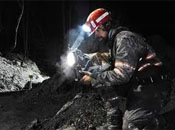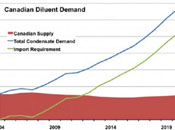Given that large portions of our nation are facing serious drought conditions, there are justifiable concerns about our water supply. Some groups interested in blocking oil and gas development have preyed on these concerns, claiming hydraulic fracturing uses extraordinarily large volumes of water and, by extension, will cause water shortages all across the country. Unfortunately for the public, the whole truth about industries' water usage – who uses water, how much they use, and where they use it – is not commonly discussed, which is exactly what opponents of development want.
To fully understand this issue, it's important to analyze real-world data relating to water consumption.
For example, let's look at Pennsylvania: Power plants in the state use 6.43 billion gallons of water every day. As a state well-known for its farms, the Commonwealth also uses 86.1 million gallons per day for agriculture and irrigation, and private water wells use 152 million gallons per day.
A hydraulic fracturing job, by comparison, only requires about four million gallons of water, spread out over several days.
Here are a few other contextual examples:
- Four million gallons of water is approximately the amount that is emptied every second from the Mississippi River into the Gulf of Mexico.
- New York City consumes four million gallons of water every 6 minutes.
- Four million gallons is about 1.3 percent of the amount of water used in car washes every day.
- Just one of the 15,889 golf courses across the United States uses four million gallons of water in less than one summer month.
Gee, hydraulic fracturing doesn't seem to have the large water-use-impact it is often prescribed, does it?
Still, water is water and certain regions are more susceptible to shortages than others. From water withdrawal limits to recycling standards, the use of water is strongly regulated throughout numerous industries. Many river basin commissions and authorities overseeing water withdrawals set protective limits in low flow periods to ensure enough passby flow to support wildlife and other water uses. And when our nation is in a period of drought it is of even greater importance that these types of regulations and guidelines are properly carried out.
But how does the practice of hydraulic fracturing factor in to water use in these states?
Let's look at Colorado, certainly no stranger to oil and gas development, and where water scarcity is of constant concern:
- Agriculture and irrigation are two of the largest users of water, consuming 85.5 percent of the state's supply.
- As the New York Times reported in September, "Oil and gas companies estimate that they will use about 6.5 billion gallons of water in Colorado this year, and that figure makes up only 0.1 percent of overall water use, according to state data. Their consumption represents more water than is used making snow on the ski slopes or greening the state's golf courses. But it is paltry compared with the deluge needed for irrigation and agriculture, which accounts for 85.5 percent of Colorado's water use."
In Texas, a state well known for oil and natural gas development, the use of water for production is minimal – which is good, because large portions of the state are dealing with drought or near-drought conditions.
- According to the Tarrant Regional Water District, oil and natural gas development represents 0.5 percent of total water demand.
- Darrell Brownlow, geologist and member of the South Central Texas Regional Water Planning Group, states that "for every one acre-foot of water used in fracking, 280 acre-feet acre used for other purposes in South Texas." (San Antonio Express, 11/2/2011)
- According to the Texas Water Development Board (TWDB), water use for mining activity (which includes oil and gas) wasonly 0.5 percent as compared to other water use categories such as municipal demand, manufacturing, steam electric, irrigation and livestock.
Similarly, Oklahoma has found energy development plays a relatively minor role in its overall water usage:
- The Oklahoma Water Resources Board states that many if not most of their permits issued, "including those specified for hydraulic fracturing, range from one to about thirty acre-feet of water. Regular permits issued for public water supply, irrigation, and other large-scale uses often authorize hundreds to thousands of acre-feet annually. And while significant growth is anticipated in the state's oil and gas industry, that particular use sector is projected to account for only five percent of Oklahoma's total water demand in 2060." (Oklahoma Water Resources Board, May 2012)
In the Northeast, development of the Marcellus shale has brought countless benefits to communities, including jobs, revenues and clean-burning energy. And compared to the state's rich agricultural business, water demand is comparatively low:
- According to the Pennsylvania Fish and Game Commission, irrigation and aquaculture practices alone account for over500 million more gallons of water use each day than all natural gas development in the Marcellus Shale. In fact, daily water consumption rates for drilling activities in the Marcellus shale rank below the amounts used for nuclear power generation, agriculture, livestock, irrigation, mining and all public and domestic use.
- According to a report for the U.S. Department of Energy, "Estimates of peak drilling activity in New York, Pennsylvania, and West Virginia indicate that maximum water use in the Marcellus Shale, at the peak of production for each state,assuming 5 million gallons of water per well, would be about 650 million barrels per year. This represents less than 0.8 percent of the 85 billion barrels per year used in the area overlying the Marcellus Shale in New York, Pennsylvania, and West Virginia." (DOE, June 2010)
- John Arway, Executive Director of the Pennsylvania Fish and Boat Commission, noted in 2011 that the Marcellus Shale used 1.9 million gallons of water per day. (PFBC, January 2011)
- The Susquehanna River Basin Commission (SRBC) indicates total Marcellus Shale water use "represents a little more than half of the amount currently used consumptively by the recreation sector (golf courses, water parks, ski resorts, etc.)" (SRBC, February 2009)
- According to the New York Department of Environmental Conservation, "peak activity high-volume hydraulic fracturing would result in increased demand for fresh water in New York of 0.24%." (NY SGEIS, p. 6-10 [p. 20 in PDF], September 2011)
All energy sources require water, and natural gas development is no different. But how do natural gas and hydraulic fracturing stack up to other energy sources?
- According to the Union of Concerned Scientists, a typical 500-megawatt coal-fired power plant draws about 2.2 billion gallons of water each year from nearby source to create steam for turning its turbines – the equivalent of 550 hydraulic fracturing jobs.
- By nature of its design, solar energy is the most effective in regions where the sun is most intense. As a result, it tends to be most effective in areas with scarce water supplies. In California, disputes over solar projects in the Mojave Desert, the city of Bakersfield and elsewhere have been delayed due to massive water needs in areas with little access to natural sources. The Mojave solar farm being built by Abengoa Solar plant will require 705 million gallons of water annually to operate – equivalent to more than 176 hydraulic fracturing jobs.
- Similar concerns over water use are seen in the production of biofuels. According to the Arizona Water Institute, "A significant potential issue with biofuels, especially in an arid state such as Arizona, is that they require large amounts of water to produce feedstock. With an average annual evapotranspiration rate of between 3 and 8 feet, there are very few locations within the state that receive enough rainfall to get by with no or even little irrigation."
- According to the USDA, when the feedstock in biofuels is corn or soy (used to make ethanol and biodiesel, respectively) and grown on irrigated land, then the water consumption per gallon of fuel produced can exceed the water consumption for refining by a factor of one thousand.
As Tisha Schuller, president of the Colorado Oil and Gas Association, noted in the New York Times this September, "This is an important use of our water — to produce energy, which is the foundation of all we do." Schuller continued: "Think about the big users of water — agriculture, industrial development. All these things require energy."
As technological advancement continues, industry is reducing the use of freshwater sources, enhancing recycling efforts and decreasing the natural gas industries footprint on America's precious water resources. Along the way, the development of natural gas from shale has created immense benefits across the nation while providing an affordable and clean burning fuel for American consumers.
So yes, hydraulic fracturing uses water. And when opponents present the total volume used – millions of gallons – without any context, it can sound frighteningly large. But the public should be made aware of facts like relative use and total demand, because when the whole story is told, water needed for hydraulic fracturing sounds a lot less scary. That might not make great fundraising emails for groups opposed to oil and gas development, but it's the truth.
Dana Bohan
Energy InDepth























































